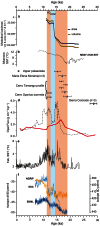Rapid thinning of the Late Pleistocene Patagonian Ice Sheet followed migration of the Southern Westerlies
- PMID: 23817136
- PMCID: PMC3698495
- DOI: 10.1038/srep02118
Rapid thinning of the Late Pleistocene Patagonian Ice Sheet followed migration of the Southern Westerlies
Abstract
Here we present the first reconstruction of vertical ice-sheet profile changes from any of the Southern Hemisphere's mid-latitude Pleistocene ice sheets. We use cosmogenic radio-nuclide (CRN) exposure analysis to record the decay of the former Patagonian Ice Sheet (PIS) from the Last Glacial Maximum (LGM) and into the late glacial. Our samples, from mountains along an east-west transect to the east of the present North Patagonian Icefield (NPI), serve as 'dipsticks' that allow us to reconstruct past changes in ice-sheet thickness, and demonstrates that the former PIS remained extensive and close to its LGM extent in this region until ~19.0 ka. After this time rapid ice-sheet thinning, initiated at ~18.1 ka, saw ice at or near its present dimension by 15.5 ka. We argue this rapid thinning was triggered by a combination of the rapid southward migration of the precipitation bearing Southern Hemisphere (SH) westerlies and regional warming.
Figures



References
-
- Denton G. H. et al. The Last Glacial Termination. Science 328(5986), 1652–1656 (2010). - PubMed
-
- Sime L. C. et al. Southern Hemisphere westerly wind changes during the Last Glacial Maximum: model-data comparison. Quat. Sci. Rev. 64, 104–120 (2013).
-
- Clark P. U. et al. The Last Glacial Maximum. Science 325(5941), 710–714 (2009). - PubMed
-
- Denton G. H. et al. Interhemispheric linkage of paleoclimate during the last glaciation. Geogr. Ann. 81A(2), 107–153 (1999).
-
- Schaefer J. M. et al. Near-synchronous interhemispheric termination of the last glacial maximum in mid-latitudes. Science 312(5779), 1510–1513 (2006). - PubMed
LinkOut - more resources
Full Text Sources
Other Literature Sources
Miscellaneous

